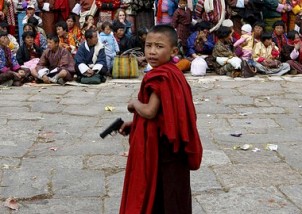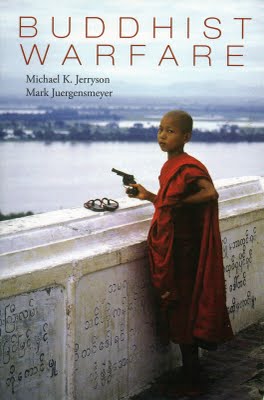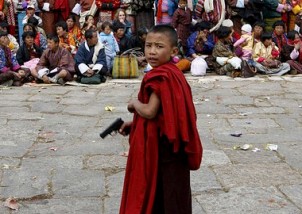不知情的读者看了这本Jerryson 与Juergensmeyer合作研究泰国武装喇嘛的着作《僧侣、枪械:发现佛教暴力》,会以为佛教真的含藏暴力。事实上,这些僧侣都不是真正的佛,而是喇嘛。从作者对武僧的访谈中,很清楚看到他们与伊斯兰的冲突;而这正是喇嘛教与伊斯兰教的宿世仇恨,在喇嘛教的重要根本典籍《时轮续》即明示了必须毁灭伊斯兰教,杀死一切异。如此暴力、仇恨、好战的宗教,绝非佛教,而是披着佛法外衣的喇嘛教/密宗/藏传佛教。两位作者广阅了研究、蒙古、斯里兰卡、印度…等地佛教暴力历史的论文,可惜独漏了最重要的《时轮续》。《时轮续》已经清楚的指示出喇嘛们的暴力本质,从这裡可以很明确判别喇嘛教非佛教、武僧非佛。
〔转贴文章〕Monks With Guns: Discovering Buddhist Violence
By MICHAEL JERRYSON
〔转贴来源〕RD Magazine January 12, 2010

Buddhist monk with toy gun. Bhutan, 2008. (小喇嘛持玩具枪,不丹,2008。)
The publication of Buddhist Warfare, a book I co-edited with Mark Juergensmeyer, is a bittersweet experience as it marks the culmination of a journey that began with an exploration of the peaceful aspects of Buddhism only to end up chronicling portions of its dark side. This journey, which consumed much of the last six years of my life, began in 2003 when my wife and I spent a little over a year in Thailand. It was then that I began to research Buddhist social activism which was going to be the topic of my dissertation.
Rather than look to archives, I decided to speak with Buddhist monks and nuns on the ground. I interviewed monks protecting the forests from big business and villagers from dangerous pesticides; I met and began to chronicle the activities of the first fully ordained Thai Buddhist nun, Dhammananda Bhikkuni; and I met with Thai Buddhist monastic intellectuals.
Military Monks
Then in January 2004, violent attacks broke out in the southern provinces of Thailand, some of which were directed at Buddhist monks. These attacks and the numerous ones to follow shocked the country. But, since contemporary issues and my research interests seemed to be converging, I thought: what better way to study Buddhist activism than to observe Buddhist monks engaged in peacemaking?
Unfortunately, I found very little of this.
During my visits between 2006 and 2008, southern Thai monks shared the challenges of living in their fear-infested communities. All but a few concentrated on survival; peacemaking was the last thing on their minds.
The constant fear and violence took a toll on them. Monks talked about the guns they had bought and now kept at their bedsides. Others spoke heatedly about the violent militant attacks on Buddhist civilians and monasteries. Although the cause of the violence is multilayered—owing much to corruption, drug trade, and corporatization—many monks also felt Islam was to blame. In their minds, the conflict was anchored to the larger discussion of religious violence: Muslims against Buddhists.
One day after teaching an English class for Buddhist novices at a monastery a young monk came over and pulled back the folds of his robe to reveal a Smith Wesson. I later learned that he was a military monk—one of many covert, fully ordained soldiers placed in monasteries throughout Thailand. To these monks, peacemaking requires militancy.
Since my initial realization in 2004, I began to look critically at my earlier perspective on Buddhism—one that shielded an extensive and historical dimension to Buddhist traditions: violence. Armed Buddhist monks in Thailand are not an exception to the rule; they are contemporary examples of a long historical precedence. For centuries monks have been at the helm, or armed in the ranks, of wars. How could this be the case? But more importantly, why did I (and many others) hold the belief that Buddhism=Peace (and that other religions, such as Islam, are more prone to violence)?
Buddhist Propaganda
It was then that I realized that I was a consumer of a very successful form of propaganda. Since the early 1900s, Buddhist monastic intellectuals such as Walpola Rahula, D. T. Suzuki, and Tenzin Gyatso, the Fourteenth Dalai Lama, have labored to raise Western awareness of their cultures and traditions. In doing so, they presented specific aspects of their Buddhist traditions while leaving out others. These Buddhist monks were not alone in this portrayal of Buddhism. As Donald S. Lopez Jr. and others have poignantly shown, academics quickly followed suit, so that by the 1960s U.S popular culture no longer depicted Buddhist traditions as primitive, but as mystical.
Yet these mystical depictions did not remove the two-dimensional nature of Western understanding. And while it contributed to the history of Buddhism, this presentation of an otherworldly Buddhism ultimately robbed Buddhists of their humanity.
Thupten Tsering, the co-director of Windhorse, encapsulates the effects of two-dimensional portrayal in a 1999 interview with the New York Times. They see Tibetans as cute, sweet, warmhearted. I tell people, when you cut me, I bleed just like you.
In an effort to combat this view and to humanize Buddhists, then, Mark Juergensmeyer and I put together a collection of critical essays that illustrate the violent history of Buddhism across Mongolia, Tibet, Japan, China, Korea, Thailand, Sri Lanka, and India.
Our intention is not to argue that Buddhists are angry, violent people—but rather that Buddhists are people, and thus share the same human spectrum of emotions, which includes the penchant for violence.

Although the book only arrived at bookstores last month, it apparently touched some nerves in the academic community before its release. Some have objected to the cover, which they feel is not an appropriate subject for Buddhism. Ironically, that is the very reason this collection of essays is so important: to address the apparent and widespread inability to acknowledge the violent side to religious traditions. It is this inability that robs its adherents of their humanity.
In a way, I wish I could return to that dream of Buddhist traditions as a purely peaceful, benevolent religion that lacks mortal failures and shortcomings. But I cannot. It is, ultimately, a selfish dream and it hurts other people in the process.
Buddhist Warfare certainly contributes to the broader discussion of religious violence, but on a more intimate and local level, I hope this collection will effect some significant change in the way Buddhism is perceived in the United States. only time will tell.
Michael Jerryson:
MIchael Jerryson is co-editor with Mark Juergensmeyer of Buddhist Warfare, the first collection of essays on Buddhist violence from a comparative perspective (New York: Oxford University Press, 2010).
